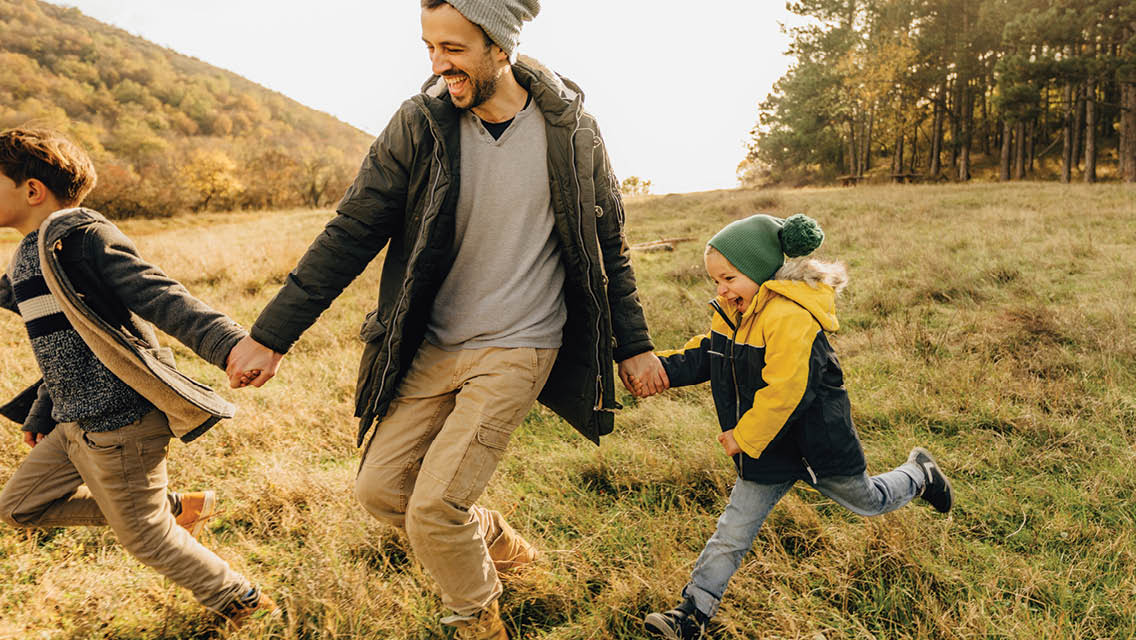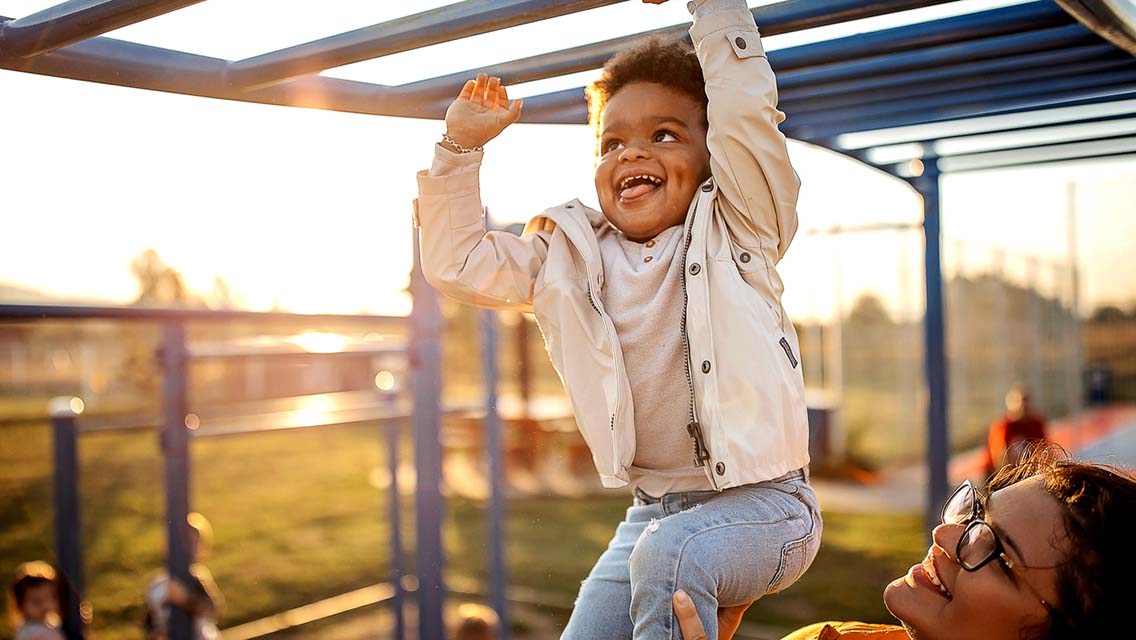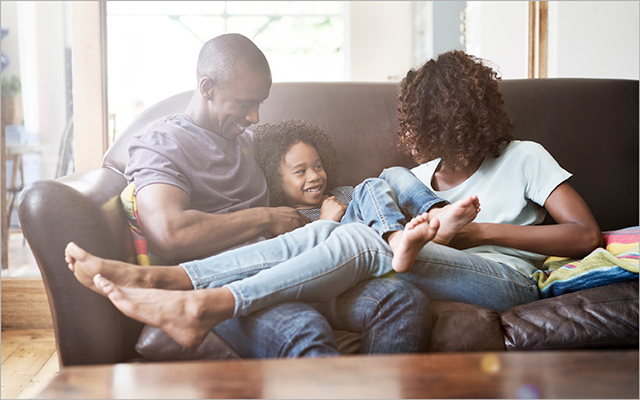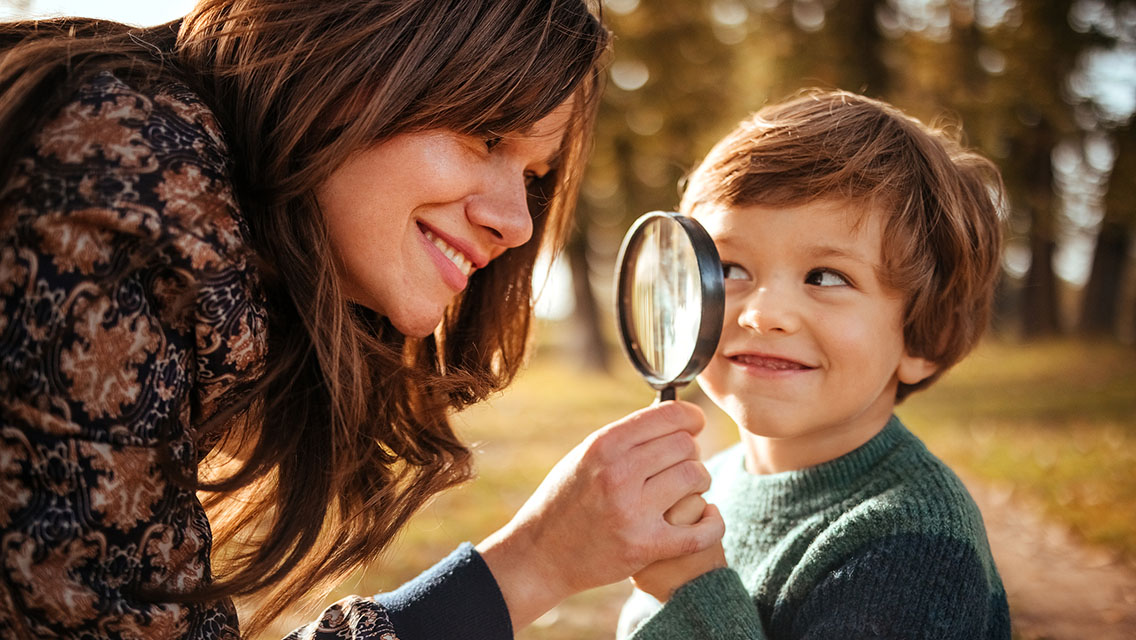Explore this article:
It was a beautiful October day and yet the kids were edging toward the Xbox. Gathered in our family room were my 9- and 12-year-old sons, two of their friends, and my 4-year-old daughter trying to insert herself in the middle. Could I somehow move this party outside? I wondered. I really wanted to go for a walk but taking this crew along seemed (a) overly ambitious and (b) possibly disastrous.
Still, I spat out the words before I could overthink the outcome. “Everyone put on your shoes. We’re going to the woods.” While my kids are used to my spontaneous walks, I had no idea how their friends would react.
Preteens like to be in charge, so I wasn’t surprised that each had stipulations. The eldest wanted to bike to the forest while the rest of us drove; the middle ones grabbed a ball and announced that they would be playing soccer on the trail. The littlest added a stuffed unicorn to our crew.
At the river, we ended up under a bridge, playing our own version of soccer that involved kicking the ball at a specific part of the graffiti to score a goal. On our way back, an attempt to rescue the soccer ball from a creek resulted in a lost shoe and a group rescue mission to retrieve it.
We hung from branches, climbed trees, and balanced on logs. We were happy, muddy, sweaty, and invigorated.
“When you take the thing you were already going to do and add other people, I call this adding ‘vitamin community,’” says biomechanist Katy Bowman, founder of Nutritious Movement and author of Grow Wild. “Adding community immediately makes a task more nourishing, and suddenly — magically — it is easier to get everyone moving more.
“We can take a walk in the woods alone and meet some of our needs, or we can go with our immediate family and meet even more needs. Or we can go with a more diverse community that is made up of individual needs but focused on a collective goal. It is the latter that produces the richest, most rewarding experience.”
When you’re with the people you love, sharing in movement is not only physically rewarding but also a powerful relationship builder. Movement connects us and brings us closer together. It cuts across generational lines and sparks joy and camaraderie. It can foster beneficial life skills and values, including teamwork and determination.
Give some of these 100 ideas a try to get moving with your family, friends, community, or whoever else is near and dear to you.
Start Small
To kick off your multiperson movement dreams, start by (1) taking a stroll. Simply going for a walk around the block with a family member can make it easier to connect.
“When you go for a walk, it brings your stress level down, so you can think a little more clearly and begin to move through your feelings,” says therapist Jennifer Udler, LCSW-C, author of Walk and Talk Therapy: A Clinician’s Guide to Incorporating Movement and Nature Into Your Practice.
“What’s unique about walking with someone else is that you’re seeing more of that person — their body language, their pace, their energy. There’s a bit of vulnerability in that, but that’s also how we learn to trust, grow, and build relationships.”
If your group includes young kids or skeptical movers, start small. “The first best thing you can do is just walk out your front door,” suggests James Edward Mills, founder of the Joy Trip Project and author of The Adventure Gap: Changing the Face of the Outdoors. Then consider the relevance of your walk to everyone in your group: “Ask yourself, What are they going to get out of it?”
(To learn about all the amazing and wonderful benefits walking has to offer, visit “The Powerful Health Benefits of Walking.”)
One way to get your group on board is to (2) choose a destination that you can agree on — this can be as simple as walking with your kids to the ice cream shop.
Explore other ways to get to your destination. You can (3) go for a bike ride, or maybe the variety of ages and abilities in your group means everyone goes their own way: a combination of (4) scootering, stroller pushing, dog walking, wagon pulling, wheelchair rolling — whatever works!Life Time personal trainer Anna Taylor and her husband (5) run intervals, pausing for catch-up breaks at stop signs while their three young children ride their bikes.
Expand your surroundings and (6) go for a nature walk in your local forest, arboretum, or preserve. “Being outside in nature offers a direct connection with the natural world and the balanced rhythms of life on our planet,” says Mills. “When we have the ability to share and express our love of nature and love of the people around us, it has an exponentially compounding effect.”
Instead of focusing on the destination or reward at the end, mix things up, slow it down, and appreciate the journey. (7) Do a scavenger hunt in which everyone collects items or takes pictures of the things on the list. (8) Get a book of birds and see how many you can spot, or (9) make a journal of plants you see and use an app to identify them.
To keep it relevant for your sporty kid, (10) bring a ball and try kicking it along the trail. Or head off trail and (11) play the floor is lava, trying to make your way around an area without touching the ground. Or (12) make up your own obstacle course incorporating your surroundings — trees are great for climbing, hanging, and balancing.
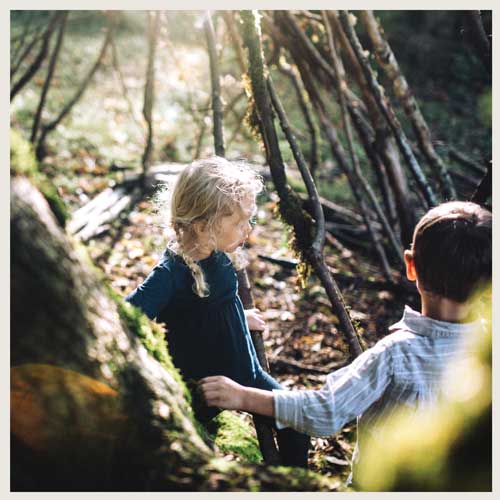 You can all work as a team and collect branches to (13) build a fort. Kids’ imaginations run wild in natural settings, so you might find yourself playing a role in their make-believe schemes, whether it’s (14) seeking out unicorns or (15) escaping from pirates!
You can all work as a team and collect branches to (13) build a fort. Kids’ imaginations run wild in natural settings, so you might find yourself playing a role in their make-believe schemes, whether it’s (14) seeking out unicorns or (15) escaping from pirates!
If your group includes some explorers, they might enjoy (16) geocaching, using GPS tracking units to locate containers or caches at specific coordinates on a map. Your teenager and a grandparent may be equally enthusiastic about (17) searching for treasures with a metal detector.
Be sure to bring water and snacks, wear the right clothing for your activity, and don’t forget the sunscreen and bug spray. Plus, be wary of poison ivy and remember to check for ticks.
“One important thing, perhaps more than anything else, is to make all your experiences manageable,” says Mills. “The minute it becomes complicated, it becomes burdensome and less pleasurable.”
Make the Adventure Bigger
“Once you get in the habit of recreationally spending time outdoors, you might try to expand the things you do,” Mills advises. Be careful to set realistic expectations and make sure everyone in your group is on board.
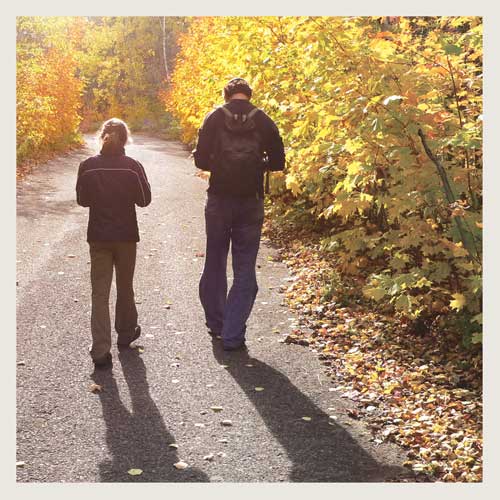 To make your experience more physically challenging, try (18) hiking or trail running or (19) rucking, which is basically just walking while wearing a weighted backpack (or your 2-year-old). Pause for a break alongside the trail and (20) do a body-weight workout together.
To make your experience more physically challenging, try (18) hiking or trail running or (19) rucking, which is basically just walking while wearing a weighted backpack (or your 2-year-old). Pause for a break alongside the trail and (20) do a body-weight workout together.
Pursuing a skill-based activity such as (21) mountain biking or (22) horseback riding can be a gratifying experience for a group of people who share similar fitness levels and coordination abilities. Or try a paddle sport — which can include (23) canoeing, (24) kayaking, or (25) stand-up paddleboarding.
(26) Do a high-ropes course — it’s a fun challenge to take on as a family and doesn’t require any skill or experience.
Make it an overnight adventure and (27) go camping. You’ll move your body a ton between setting up camp, collecting firewood, carrying water, and preparing meals together. Plus, most campsites are close to hiking trails and other venues for outdoor activities.
For your next family vacation, (28) agree on a locale where you can enjoy multiple active pursuits and build your itinerary around movement. Depending on where you go and what type of weather you encounter, activities might include (29) swimming, (30) snorkeling, (31) surfing, (32) sledding, (33) downhill skiing, (34) snowboarding, (35) cross-country skiing, or (36) snowshoeing.
Make Your Home Movement-Friendly
Modifying your home environment is one of the simplest ways to make movement more accessible, says Bowman. Start by (37) prioritizing open space to dance, tumble, or play safely. Even if your home doesn’t feature a big floorplan, you can (38) minimize your furniture to reduce time spent sitting in chairs.
Bowman also notes, “Check in with your (39) spoken and unspoken rules about movement and adjust as necessary. How often do you tell your kids to sit down? To stop running or jumping? Sometimes these rules need to be in place, but other times they don’t.”
Being open to playfulness and spontaneity sends your kids the message that movement and exercise are things we can do anywhere, anytime. “I think the important thing is we don’t associate fitness only with the gym,” says Jacob Rivera, CSCS, USAW, performance manager with Children’s Health Andrews Institute Sports Performance powered by EXOS. “Associating fitness with [all the] ways we can move is really key.”
 The next time everyone is acting stir crazy, clear some space and (40) initiate a pillow fight. Or (41) set up an obstacle course that spans your home and ask the kids to help design the obstacles. You can crawl under chairs, jump over cushions, and tightrope-walk on floorboards.
The next time everyone is acting stir crazy, clear some space and (40) initiate a pillow fight. Or (41) set up an obstacle course that spans your home and ask the kids to help design the obstacles. You can crawl under chairs, jump over cushions, and tightrope-walk on floorboards.
Accessorize your home with hanging elements so everyone can work on grip and upper-body strength. “There are lots of kits that allow you to (42) add rings or a hanging bar on strong beams,” says Bowman. “Now we have a few rock-climbing holds on one beam and a chin-up bar in the doorway. It’s an inexpensive way to add grip-, arm-, and shoulder-strength time throughout the day.”
(43) Give your kids “rides.” A few you can try are wheelbarrows (hold their feet while they walk on their hands), mechanical bull (they try to hold on while you wriggle around on all fours), and piggyback rides. Or incorporate your littles into your workout: (44) Play the over/under game, during which you assume plank, downward-facing dog, or another position and your kids (and possibly pets) climb over or under you.
You can (45) squat with your toddler (get creative: do a body-weight squat when your kiddo does, or squat while holding them), or (46) do pushups alongside your teenager. When working out with kids, keep it lighthearted and lower your expectations. Rather than counting reps and sets, just get everyone moving.
Put on some upbeat music and (47) have an after-dinner dance party. You can watch a YouTube or TikTok video and learn how to do a (48) dance together. Some gaming consoles have multiplayer dance or sports games, so you can (49) swap sedentary screen time for Just Dance or EA Sports.
Play an active old-school game like (50) Twister and get tangled up together. Grab a pair of dice and play a (51) workout game: Label the sides of one die with exercises; on the other die, indicate the number of reps.
(52) Ground your everyday activities. Move your kitchen table, spread out a blanket, and have a picnic in the kitchen. If you play games as a family in the evenings, move them to the floor. “This is an easy way for everyone to stretch any desk-chair or work-chair tension from their body while also getting that family connection,” says Bowman.
Get Moving in the Backyard or at Your Local Park
Your nearby green space offers a convenient way for your crew to sneak in casual, impromptu movement. It doesn’t take a lot of planning to go outside and throw a ball around, but it can mean a lot to a kid — and is a great way for grown-ups to add more movement to their days.
(53) Practice throwing and catching a baseball or football, or play monkey in the middle. (54) Kick a soccer ball back and forth or (55) set up mini goals and have a scrimmage. (56) Toss a Frisbee and let your dog in on the fun.
Set up a net to (57) play badminton or (58) volleyball, or try (59) Spikeball (a cross between volleyball and four square). (60) Shoot hoops or (61) play a game of H-O-R-S-E in the driveway. (62) Jump on the trampoline together.
Get creative and set up a (63) backyard obstacle course or (64) doggy agility course using props such as two-by-fours, hula hoops, tires, and whatever else you find. Go old school with (65) hopscotch, (66) four square, or (67) jump rope.
(68) Organize your own running races: Start at one corner of your block and set a stopwatch to time each family member’s one-block run. Or (69) host your own family Olympics with multiple events.
Take your kids to the park and join them while they (70) climb on the monkey bars and other playground equipment. “Sometimes the kids will call us over to the playground and we all play — it’s that organic way of connecting and playing rather than being forceful or having too much structure,” says personal trainer Anna Taylor.
Include Older Family or Community Members
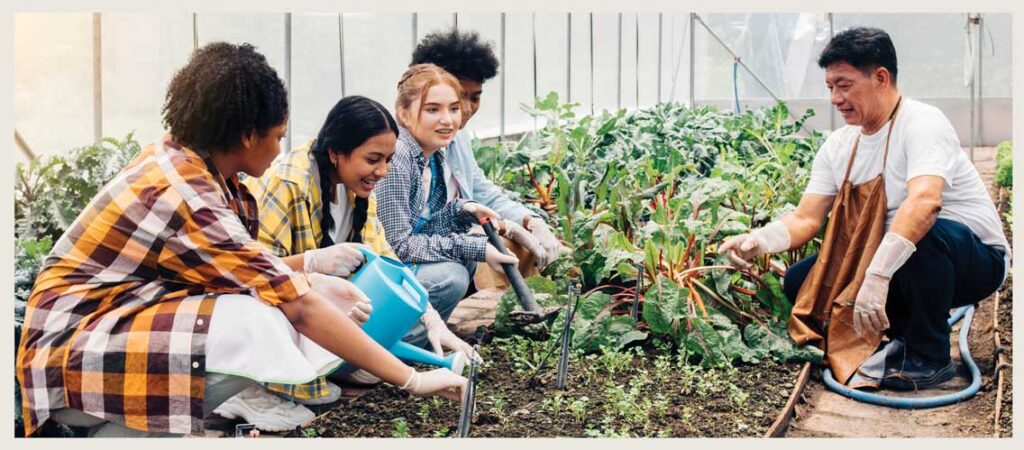
In our fast-paced world where generations may struggle to find common ground, movement is universal. “When it comes to movement for mixed abilities, remember that there are many ways to move a body,” notes Bowman. (71) “Gardening, (72) playground time, (73) playful dancing, (74) doing art, or (75) cooking and baking are a few examples of movements where everyone can go at their own pace and ability.”
Sports and games that accommodate a wide range of ages include (76) bowling, (77) beanbags/cornhole, (78) mini golf, (79) disc golf, and (80) pickleball, which has exploded over the past few years. “Pickleball is a great equalizer — a 10-year-old can play with an 80-year-old,” says Rivera.
Everyone wins when mixed generations move together. “Youth can learn new physical skills from older members, while the older generation can stay updated with new trends and technologies through the younger ones,” says Sabrena Jo, PhD, director of science and research at the American Council on Exercise. “Intergenerational activities help to break down stereotypes about age, promoting understanding and respect across generations.”
Do a Task Together
Movement doesn’t have to be an extra item on your to-do list. It can be layered into your daily routine, says Bowman. “‘Stacking’ is looking for a single task that meets multiple needs. It’s different than multitasking, which is trying to juggle more than one task in a single bout of time,” she explains.
For example, instead of everyone sitting down to study alone at their desks, “swap in (81) a family walk in the evening, where you practice spelling words, math facts, or play lines while also moving together. You’re getting outside time, family time, education, and movement all in that single task,” Bowman says.
Consider the activities your family already does together and see whether you can layer more movement into them. Or take an active task and make it a family affair: (82) Divvy up the chores of gathering kindling and chopping and carrying wood to make a fire. (83) Rake leaves together. Tackle the job of (84) weeding the garden. (85) Build a treehouse or backyard play structure. (86) Cultivate an indoor garden by growing herbs, flowers, and vegetables from seed. (87) Wash the car by hand.
Or use your collective skills to help others: (88) Shovel an older neighbor’s sidewalk. (89) Help your local forest preserve with invasive-species removal. Sign up to help with an (90) active service project, such as cooking and serving people dinner.
Take a Fitness Class
Taking a class and learning something new with a loved one can be a great way to bond; it can also reduce the fear of jumping into unknown territory. (91) Challenge a fitness-loving workout partner to join you for an advanced exercise class, like Life Time’s Alpha or Ultra Fit.
On the other end of the spectrum, seek out yoga studios that offer (92) parent-child yoga classes, and (93) martial arts classes for mixed-age groups. (94) Tai chi is gentle enough to do with older family members, and (95) Zumba might be fun to try with your friend who loves to dance.
(96) Schedule semiprivate tennis or golf lessons with a partner or close friend — it can be a fun way to improve your game and spend time together. Or (97) try small-group or partner personal training if you have similar fitness goals.
Going to the health club together, even if you do separate programs or classes, is a great way to model healthy habits. “You’re creating a sense of family engagement in a healthy lifestyle,” says Taylor.
Train for a Common Goal
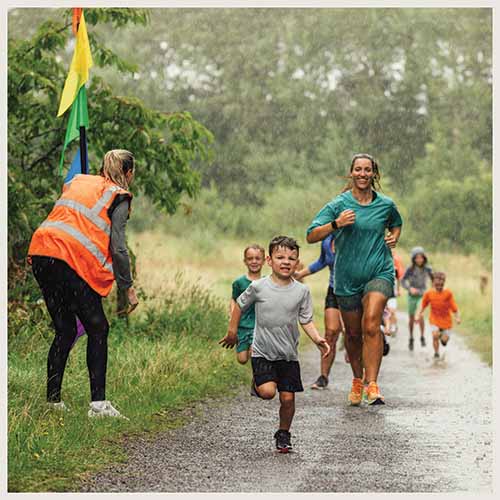 When we belong to a team, we connect through the shared experience of working toward a goal, overcoming adversity, and supporting one another. For families, this bond can be especially meaningful.
When we belong to a team, we connect through the shared experience of working toward a goal, overcoming adversity, and supporting one another. For families, this bond can be especially meaningful.
“To sweat together and work out and be together, you start to develop a deeper bond similar to being on a team,” Rivera explains. “It’s great if you can do this with family.”
(98) Doing a 5K run or walk is a reasonable goal for people at a range of fitness levels, and a charity event makes it even more meaningful. Up the challenge by (99) tackling a trail run together. Our family (100) completed a mud run together, which was fun and got us outside to train in the muddiest weather.
Incorporating these types of activities into family life nurtures relationships, emotional well-being, and a sense of achievement, says Jo. “And then, of course, when the goal is achieved, celebrating together is even more satisfying than when done alone.”
